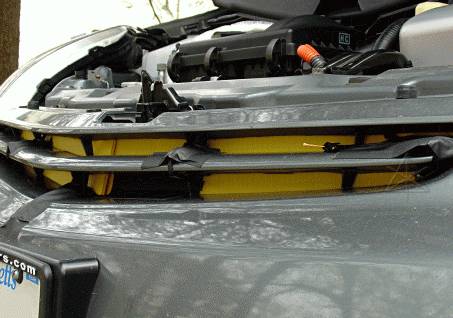And finally, grille airflow block-offs!

As if all of the foregoing wasn't enough, a discussion that sprang up around
the overall efforts also mentioned the benefits of blocking off heat-robbing
airflow through the radiator and thence around the engine. Obviously, a
strong flow through the engine compartment at highway speed is going to wash
a lot of heat away under the car, and since the whole idea here is to hold
the HEAT in the HEAT ENGINE where it belongs, keeping the cold air out of
there totally makes sense. The engine block presents nontrivial radiative
surface area, for which there's no thermostat controlling rate of heat
transfer. Some people have gone to extremes of packing wads of fiberglass
insulation all in around the engine to keep it cozy. I figure just getting
the highway airflow somewhat under control helps a bit...
After looking critically at the grille construction and the relationship
with where the radiator and engine-room opening sit, it's pretty clear that
the top "smiley" opening is pretty useless, so I've used two pieces of
Coroplast to completely close it. They're tied through punched holes and
then around the plastic struts, and flex very nicely up against the edges
of the opening inside. It's yellow because I'm reusing signage from the
2006 Ipswich renewable energy festival. The stuff cuts easily, it's
fairly strong and weatherproof, and was in near-to-hand cache in the house.
The ends of the ties are then taped down to prevent them from flapping
around; this part is semi-permanent and may not even come off for summer
since it possibly helps a little more air go up and over the car too.
Since the whole nose of the car is plastic, I'm not worried about trapping
moisture or pulling up paint.

The lower opening is much larger and is pretty clearly where most of the
air comes in. It probably circulates quite a bit in the large space in
the nose before heading through the radiator; however, one must remember
that the section of radiator that handles inverter coolant is at the
bottom of the assembly. It therefore seems sensible that if any part of
this is going to have an easily-changeable option, especially when planning
a road-trip to warmer climates, it should be the lower part. So this is one
large piece, mounted on loose loops of tie-line at the lower corners and
with a long piece near the top that allows it to flop completely back and
allow full airflow in to the radiator.

When pulled up and tied more tightly, though, it closes off the center
part of the lower-opening grille but leaves the very outer sections [which
are physically separate plastic inserts anyways] open. These are not
directly in front of the radiator but have little angled plastic deflectors
behind them to send the air more or less inward; I figure I'll leave these
open for enough airflow to handle minimal cooling needs for the inverter
and the main radiator. I wouldn't really expect a high load in cold
weather, but any engine will get plenty warm when climbing a long hill so
*some* cooling capacity needs to be left in. It's just out of the direct
oncoming blast at highway speeds now.

The assembled whole gives the car a new oddly aggressive aspect, or maybe
it's just the camera angle... still, warmup time and heat-holding does seem
to be improved after highly sophisticated technical testing [i.e. drive for
a while with an eyeball on ECT and IAT via OBDII, get out, feel around under
the hood] without undue heating of any components. This rig even went out
in full cold-weather mode on a freakishly balmy 65F day in November, although
after seeing intake temps climb up toward 170F I stopped and took the WAI
hose off the airbox for the rest of that particular day's run.
Let it snow!
_H* 061207



